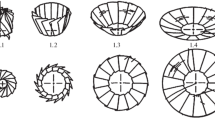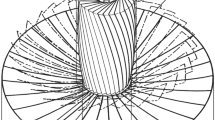Abstract
The new design of petal type deployable space antenna is presented. To improve important characteristics of reflector—deployment repeatability, reflecting surfaces accuracy, rigidity and effective area of open mirror—the new kinematic scheme of petal mirror deployment is proposed. Within developed approach the deployment of large mirror is fulfilled in two stages. During the first stage the structure is transformed with low accuracy from folded position into a state close to the working one. High precision fixing of open mirror is performed during second stage of deployment. Self-setting locks are introduced into the structure and used for micromanipulations with the petals during second stage of mirror opening. The new kinematic scheme of deployment and the design of the locks are described. At the final stage of the reflectors deployment the self-setting locks operate as compliant mechanisms.
Access provided by CONRICYT-eBooks. Download conference paper PDF
Similar content being viewed by others
Keywords
1 Introduction
Large space antennas are developed and used in a variety of scientific and technical space projects. Technical requirements for reflecting surfaces accuracy of antenna depend from operating wavelength of the instrument. Large mesh designs are effectively used for antennas operating in the long-wavelength area of spectrum (Thomson 2016). Large solid reflectors are developed for operation in short-wavelength instruments Footnote 1,Footnote 2,Footnote 3,Footnote 4. Petal type solid deployable space reflector was first suggested by Dornier Corporation within FIRST project development (Dornier 1987; Manfred Westphal (Dornier) 1990). The modified version of petal type reflector was used later for 10 m antenna of Radioastron space radio telescope (Kardashev et al. 2013; Arkhipov et al. 2008). This telescope operates at centimeter wavelengths. In order to use petal type design in the shortwave region of the spectrum it is necessary:
-
increase the accuracy of reflecting surface of open antenna,
-
enhance the rigidity of open design,
-
ensure high repeatability of deployment.
To meet these requirements the new design of petal type reflector was proposed (Bujakas 2013, 2014). Within the design the deployment of large mirror is fulfilled in two stages. During the first stage the structure is transformed with low accuracy from folded position into a state close to the working one. High precision fixing of open mirror is performed during second stage of deployment. Self-setting locks are used for micromanipulations with the petals during second stage of deployment.
2 Classical Design of Petal Type Reflector
Classical design of petal type reflector contains a central mirror and a set of petals. Each petal is connected to the frame of central mirror via cylindrical hinge. In the folded state the petals are disposed above the central mirror. The deployment is realized by synchronous rotation of the petals around the axes of cylindrical hinges, Figs. 1 and 2. The actuators are located from the back side of the central mirror. It has been shown (Dornier 1987; Manfred Westphal (Dornier) 1990) if the directions of cylindrical hinges are correctly chosen, the deployment of the petals is realized without collisions.
However the classic petal type design has a serious shortcoming—in the open state the petals are not linked. Closed parabolic shell has a significant geometric rigidity. Being cut into petals the design loses this property. Moreover if petals are large it is very difficult to ensure high accuracy for outer part of open reflector. But this part of the reflecting surface introduces a decisive contribution to the effective area of open antenna.
We consider the transformable structure where after deployment the neighbor petals are linked and use the self-setting locks to ensure high repeatability of deployment and increase the rigidity of open reflector.
3 New Design of Petal Type Reflector
Within the new design the deployment of the mirror is fulfilled by moving the vertex of one petal along the outer edge of the adjacent petal (Fig. 3), so the links between the petals are kept during deployment.
Small linear actuators are used to implement the opening of the mirror. The actuator moves along the edge of the petal, and leads the vertex of the adjacent petal. Such placements of the actuators allow performing the precise alignment of the vertices of neighboring petals of open reflector.
To implement the desirable kinematics it is necessary:
-
firstly, to weaken the connections of the petals with the central mirror; for this purpose, the cylindrical hinge that connects the petal with the central mirror; for this purpose, the cylindrical hinge that connects the petal with the central mirror in the classical design is replaced on the two-stage hinge (Fig. 4),
-
secondly, to connect the holder of the actuator with the top of adjacent petal in such way to keep the structure stress free and geometrically unchangeable in each moment of deployment; to meet these requirements the link between the holder of linear actuator and vertex of neighbor petal used in the new design contains the spherical and cylindrical hinges (Fig. 5).
The new structure consists of n petals and a central mirror. Let N—total number of solid elements in the structure,
- S1 :
-
the number of kinematic constraints introduced by links between petals
- S2 :
-
the number of kinematic constraints introduced by the links between the petals and central mirror,
- S:
-
the total number of kinematic constraints in the structure
Thus Maxwell condition (necessary condition of statically determinacy)
is fulfilled.
Direct calculations and computer model examination shows that the structure remains statically determinate indeed in each moment of deployment, if axes of hinges are correctly chosen. Therefore the structure remains stress free in each moment of deployment and is not requires precise synchronization for actuators operation during opening.
The physical model of new petal—type reflector is now under manufacturing. The petals and the central mirror of the layout have been manufactured by ArtCor Company Footnote 5 on CNC milling-machine. Elements of a model and process of fabrication are presented in Figs. 6, 7 and 8.
4 Self-setting Locks and Deployment Repeatability
To ensure high accuracy of large space structures, deployment repeatability and rigidity of open mirror the self—setting locks were proposed and developed (Bujakas and Rybakova 1998; Lake and Hachkowski 2000). To explain self-setting locks design and operation let us consider the device presented in Figs. 9 and 10. It consist the foundation equipped with three V-shaped grooves presented in Fig. 9a and heavy tripod with spherical supports (three polished balls) presented in Fig. 9b.
The position, at which the balls of tripod are located at the bottom of the corresponding grooves, is the only equilibrium state of device Fig. 10. Therefore the device is self-setting. If the walls of the grooves and spherical balls are perfectly polished the optical quality of repeatability for tripod installation on the foundation may be achieved. This wonderful and simple device is used in experimental optic during many years.
We modify the device as follows. Three V-shaped grooves and three spherical supports are placed on the lateral sides of petals according Fig. 11.
In the equilibrium state (in the open state of the reflector) the spherical supports of the petal are on the bottom of the grooves of neighbor petal and are held in this state by the elastic forces arising due to small deformation of the petals. Stages of latching of the lock are presented in Fig. 12. During final stage of the latching or initial stage of the unbuckling the deformations of the petals arise and the locks operate as compliant mechanisms.
If the spherical support displaced on the side wall of the V-shaped groove the forces component, returning the system to the equilibrium state at the bottom of the groove arise. Thus, self-setting effect is achieved.
As a result in the structure arise three closed loop of connections between petals what increase the stiffness of open reflector.
Two locked petals and the elements of self-setting lock are presented in Figs. 13 and 14.
5 Conclusions
To improve important characteristics of reflector—deployment repeatability, reflecting surfaces accuracy, rigidity and effective area of open mirror—statically determinate self-setting locks are introduced in the structure. The locks connect the neighbor petals of open reflector. The kinematic scheme of the new petal type reflector and design of the locks were described. At the final stage of the reflectors deployment the self-setting locks operate as compliant mechanisms.
References
Arkhipov MY, Baryshev AM, Kardashov NS et al (2008) Deployable antennas for space radio telescope: radioastron and millimetron missions. In: Proceedings of 30th ESA antenna workshop, ESTEC, Noordwijk, Netherlands
Bujakas VI (2013) Deployable antenna, Patent of Russian Federation, No 126199, 2013
Bujakas VI (2014) New design of petal type deployable space mirror, multibody mechatronic systems. In: Proceedings of the MUSME conference, 2014
Bujakas VI, Rybakova AG (1998) High precision deployment and shape correction of multi-mirror space designs. In: Proceedings of IUTAM-IASS symposium on deployable structures: theory and application, pp. 51–57, Cambridge, UK
Dornier, FIRST Technology study: multi surface control mechanism for a deployable antenna. Final report. Dornier Report RP-FA-D003, 1987
Kardashev NS et al (2013) “RadioAstron”-A telescope with a size of 300 000 km: main parameters and first observational results, Astronomy Reports, 2013, т. 90, No 3
Lake MS, Hachkowski MR (2000) Mechanism design principle for optical-precision, deployable instruments. In: Proceedings of 41st AIAA/ASME/ASCE/AHS/ASC structures, structural dynamics, and materials conference AIAA, 2000
Manfred Westphal (Dornier), United States Patent 4,899,167, 1990
Thomson MW (2016) The AstroMesh deployable reflector. www.northropgrumman.com/. 2016
Author information
Authors and Affiliations
Corresponding author
Editor information
Editors and Affiliations
Rights and permissions
Copyright information
© 2017 Springer International Publishing Switzerland
About this paper
Cite this paper
Bujakas, V.I., Kamensky, A.A. (2017). Self-setting Locks for Petal Type Deployable Space Reflector. In: Zentner, L., Corves, B., Jensen, B., Lovasz, EC. (eds) Microactuators and Micromechanisms. Mechanisms and Machine Science, vol 45. Springer, Cham. https://doi.org/10.1007/978-3-319-45387-3_16
Download citation
DOI: https://doi.org/10.1007/978-3-319-45387-3_16
Published:
Publisher Name: Springer, Cham
Print ISBN: 978-3-319-45386-6
Online ISBN: 978-3-319-45387-3
eBook Packages: EngineeringEngineering (R0)


















